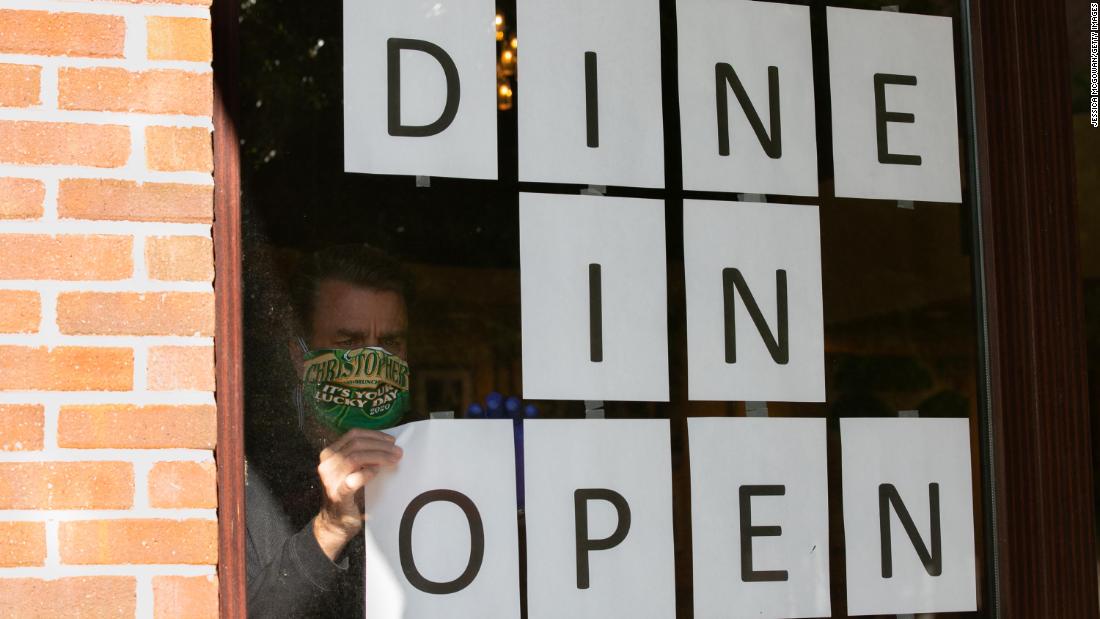[ad_1]
So if you’re reentering public spaces, it’s imperative to do it safely.
Try not to visit them all, says Dr. Leana Wen, an emergency physician and visiting professor at George Washington University Milken Institute of Public Health.
She suggests you choose one of these nonessential places to visit, then avoid the rest to limit your exposures to other people. For instance, if you go to your polling place to vote, don’t also go out to eat that night or to get your hair cut. The more public places you visit, the higher your likelihood of becoming infected or infecting others.
Restaurants
Opt to sit outdoors: If a restaurant offers outdoor seating, ask to sit there, at least 6 feet away from other diners. The virus circulates more effectively in enclosed spaces when you’re around the same people for extended periods of time, Wen said — even for the length of a dinner.
Wash your hands: Remember to wash your hands when you arrive and again before you eat. But that’s advice that should outlast the pandemic.
Beaches and parks
There’s nothing inherently bad about being outside. In fact, spending time outdoors is an excellent way to de-stress in this bizarre time, Aronoff says — as long as you do it safely.
Know when it’s too crowded to stay: If you arrive at a beach or park that’s packed, and you won’t be able to maintain 6 feet of distance from others, turn back around.
Avoid games: Avoid playing team sports like basketball or beach volleyball, too, Aronoff advises. Group gatherings still aren’t recommended, and those sports require close contact.
Gyms
That’s not to say you can’t make it work.
Wipe them down: If you’re using free weights, wipe them down before and after use. If the gym doesn’t have wipes, bring your own. Same goes for machines after you use them, Wen said.
Avoid group classes: It’s wise to avoid group fitness classes right now, she said. But if you have to attend or lead one, it may be safer to do them outside, where you’re able to maintain some distance.
Salons
Check out the safety protocols: Are the work stations at the salon or barber shop properly distanced? Are employees wearing masks or face shields, gloves and smocks? Do they disinfect tools in between clients? Are employees regularly screened for symptoms? If you’ll already be in close quarters with employees, you’ll want to eliminate other risks, Wen said.
Wait outside: While you wait for your appointment, sit outside, distanced from other people, until it’s safe to enter, Wen said.
Public transportation and ride share
Ask yourself before you ride: Do I absolutely need to use this service for an essential task? Will I take it to visit an essential location?
If the answer is no, don’t go, Wen said.
Consider alternatives: “Reserve public transportation for the people who have to take it,” like essential workers, she said. And if you don’t need it, consider alternate means of transport, like walking, biking or taking your own car if you have one.
Watch what you touch: And be mindful of every surface you touch. You may need to hold a hand rail or shut a car door, but be careful not to touch your face with your hands before you’ve washed them.
Airports
Limit your contact in the terminal: If you can, sit away from other passengers waiting to board. Bring your own food if you’re worried about hunger — many terminal restaurants and shops are closed.
Carry wipes: You can carry disinfectant wipes and hand sanitizers in your carry-on luggage, so keep them close for when you board your plane. You’ll want to wipe down the tray table, seat belt buckle, the air vent over your head — anything a previous passenger might’ve touched throughout the flight.
Clinics
Leave unnecessary guests at home: If you can avoid bringing your children, partner or friend with you to the clinic, you should. That way, they’ll limit their exposures to other people and won’t potentially infect others.
Call before you go: And always call your physician’s office before walking in or scheduling an appointment. They may ask about your symptoms before allowing you to come in, or they may’ve temporarily transitioned to telehealth for the time being.
Polling places
Keep your distance: Like always, stay 6 feet apart from other voters when you’re waiting in line or in the booths. And there should be hand sanitizer (remember, it must have at least 60% alcohol to be effective) you can use before and after you use a voting machine or complete your paper ballot.
Consider off-peak hours: If you can, come to the polling place at an off-time, when fewer voters will be packed into the room with you.
Post office
Observe the protocols: But if you do need to go in, maintain your distance from other customers. Your wait time may be delayed because of this.
Grocery store
Plan your trip: Bring a list of foods you’re there to get. It’s good to have a general sense of where they’re located in the store so you won’t spend more time in the store than you need to. Some ingredients to be out of stock, so prepare some backups.
Wipe down carts and baskets: Use a disinfectant wipe to clean handles another customer might’ve touched.
Follow the flow of traffic: Many stores have imposed one-way traffic in aisles to avoid tight squeezes. The directions aren’t always straightforward, so look for arrows on the ground to orient yourself.
[ad_2]
Source link











